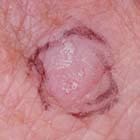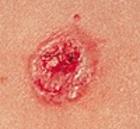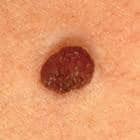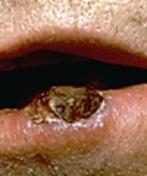Skin cancer is the uncontrolled growth of abnormal skin cells. It occurs when unrepaired DNA damage to skin cells (most often caused by ultraviolet radiation from sunshine or tanning beds) triggers mutations, or genetic defects, that lead the skin cells to multiply rapidly and form malignant tumors.
Skin cancer is the uncontrolled growth of abnormal skin cells. It occurs when unrepaired DNA damage to skin cells (most often caused by ultraviolet radiation from sunshine or tanning beds) triggers mutations, or genetic defects, that lead the skin cells to multiply rapidly and form malignant tumors.
Actinic keratoses (AK)

Actinic keratoses (AK), also called solar keratoses, are scaly, crusty growths (lesions) caused by damage from the sun’s ultraviolet (UV) rays. They typically appear on sun-exposed areas such as the face, bald scalp, lips, and the back of the hands, and are often elevated, rough in texture, and resemble warts. Most become red, but some will be tan, pink, and/or flesh-toned. If left untreated, up to ten percent of AKs develop into squamous cell carcinoma (SCC), the second most common form of skin cancer. In rarer instances, AKs may also turn into basal cell carcinomas, the most common form of skin cancer.
Basal Cell Carcinoma (BCC)

BCCs are abnormal, uncontrolled growths or lesions that arise in the skin’s basal cells, which line the deepest layer of the epidermis (the outermost layer of the skin). BCCs often look like open sores, red patches, pink growths, shiny bumps, or scars and are usually caused by a combination of cumulative and intense, occasional sun exposure.
BCC almost never spreads (metastasizes) beyond the original tumor site. Only in exceedingly rare cases can it spread to other parts of the body and become life-threatening. It shouldn’t be taken lightly, though: it can be disfiguring if not treated promptly.
In 2010, an estimated 2.8 million cases of BCC were diagnosed in the US, and the figures have continued to climb. In fact, BCC is the most frequently occurring form of all cancers. More than one out of every three new cancers is a skin cancer, and the vast majority are BCCs.
Dysplastic

DYSPLASTIC NEVI (atypical moles) are unusual benign moles that may resemble melanoma. People who have them are at increased risk of developing single or multiple melanomas. The higher the number of these moles someone has, the higher the risk; those who have 10 or more have 12 times the risk of developing melanoma compared to the general population. Dysplastic nevi are found significantly more often in melanoma patients than in the general population.
Melanoma

The most dangerous form of skin cancer, these cancerous growths develop when unrepaired DNA damage to skin cells (most often caused by ultraviolet radiation from sunshine or tanning beds) triggers mutations (genetic defects) that lead the skin cells to multiply rapidly and form malignant tumors. These tumors originate in the pigment-producing melanocytes in the basal layer of the epidermis. Melanomas often resemble moles; some develop from moles. The majority of melanomas are black or brown, but they can also be skin-colored, pink, red, purple, blue or white. Melanoma is caused mainly by intense, occasional UV exposure (frequently leading to sunburn), especially in those who are genetically predisposed to the disease. Melanoma kills an estimated 9,710 people in the US annually.
Squamous Cell Carcinoma (SCC)

Squamous cell carcinoma (SCC) is an uncontrolled growth of abnormal cells arising in the squamous cells, which compose most of the skin’s upper layers (the epidermis). SCCs often look like scaly red patches, open sores, elevated growths with a central depression, or warts; they may crust or bleed. They can become disfiguring and sometimes deadly if allowed to grow. An estimated 700,000 cases of SCC are diagnosed each year in the US, and between 3,900 and 8,800 people died from the disease in the US in 2012. Incidence of the disease has increased up to 200 percent in the past three decades in the US.
SCC is mainly caused by cumulative ultraviolet (UV) exposure over the course of a lifetime; daily year-round exposure to the sun’s UV light, intense exposure in the summer months, and the UV produced by tanning beds all add to the damage that can lead to SCC.
SCCs may occur on all areas of the body including the mucous membranes and genitals, but are most common in areas frequently exposed to the sun, such as the rim of the ear, lower lip, face, balding scalp, neck, hands, arms and legs. Often the skin in these areas reveals telltale signs of sun damage, including wrinkles, pigment changes, freckles, “age spots,” loss of elasticity, and broken blood vessels.
Reference: SkinCancer.org








